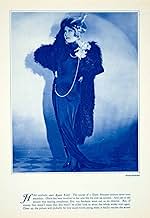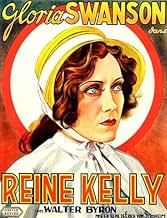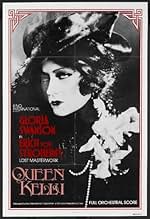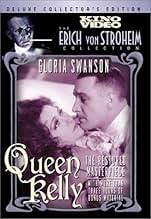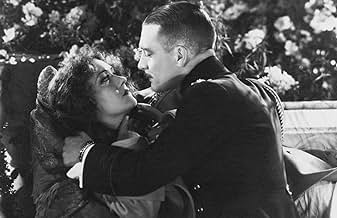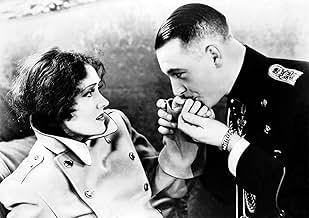AVALIAÇÃO DA IMDb
7,1/10
3,4 mil
SUA AVALIAÇÃO
Adicionar um enredo no seu idiomaA convent girl is abducted and seduced by a prince before being sent off to a brothel in East Africa.A convent girl is abducted and seduced by a prince before being sent off to a brothel in East Africa.A convent girl is abducted and seduced by a prince before being sent off to a brothel in East Africa.
- Direção
- Roteiristas
- Artistas
- Prêmios
- 1 vitória no total
Sylvia Ashton
- Kelly's Aunt
- (não creditado)
Wilson Benge
- Prince Wolfram's Valet
- (não creditado)
Sidney Bracey
- Prince Wolfram's Lackey
- (não creditado)
Rae Daggett
- Coughdrops
- (não creditado)
Robert Frazier
- Catholic Priest
- (não creditado)
Florence Gibson
- Kelly's Aunt
- (não creditado)
Madge Hunt
- Mother Superior
- (não creditado)
Tully Marshall
- Jan Vryheid
- (não creditado)
Ann Morgan
- Maid Escorting Kelly to Altar
- (não creditado)
Madame Sul-Te-Wan
- Kali Sana - Aunt's Cook
- (não creditado)
Lucille Van Lent
- Prince Wolfram's Maid
- (não creditado)
Wilhelm von Brincken
- Prince Wolfram's Adjutant
- (não creditado)
Gordon Westcott
- Lackey
- (não creditado)
- Direção
- Roteiristas
- Elenco e equipe completos
- Produção, bilheteria e muito mais no IMDbPro
Avaliações em destaque
Queen Kelly (1929)
*** (out of 4)
I think it's safe to say that von Stroheim's directing career was over when Gloria Swanson threw him a bone to direct this picture, which was originally intended to be a five-hour epic. Soon, as was always the case with the director, the thing was way over budget, he was fired and the film was never completed, although a few years later Swanson went back and filmed an alternate ending, which is included on the DVD. The film, as presented on the DVD, runs around 100-minutes and I'd say about ten-minutes are made up from stills and title cards explaining the missing footage.
The film tells the story of Kitty Kelly (Swanson), a convent girl who gets swept off her feet by Prince Wolfram (Walter Byron) but she does know that he's set to marry Queen Regina (Seena Owen) the following day. Kelly runs away in shame and finds herself in South Africa where her dying aunt turns over her brothel, which Kelly will now run. The love at first site plot isn't the most original out there but von Stroheim adds enough weirdness that makes this film worth sitting through. You can tell that this was meant to be an epic because of the 90-minutes worth of footage the first seventy-minutes are pretty much dealing with the love story. I'm guessing Kelly's rise in the brothel was originally meant to be much longer than what's shown here but I guess we'll never know as the footage is long gone and what stills are available really don't tell us too much. There are many flaws in this film but for the most part I found it very enjoyable. I thought the opening fifteen-minutes were a tad bit stiff but things really start to heat up around the thirty-minute mark. The sadistic side of von Stroheim comes through when the Queen learns that her man has been unfaithful and the whipping sequence she puts on Kelly is marvelously done and is without question one of the most beautiful shots in the director's career. You can also easily see where the budget went and the incredibly banquet scene is just a real beauty on the eyes. Swanson turns in a very good performance as she perfectly captures the spirit of the young, naive girl, although at the same time she's way too old for the part. I thought she handled the role very nicely but we never really get to see her as the brothel queen. Both Byron and especially Owen eat up their scenes and help keep the film moving. As is, QUEEN KELLY is certainly flawed but it's hard to judge the film too much simply because most of it is incomplete. The "Swanson" ending that's included on the DVD really doesn't work either so in the end we're just left with a "what if..." situation.
*** (out of 4)
I think it's safe to say that von Stroheim's directing career was over when Gloria Swanson threw him a bone to direct this picture, which was originally intended to be a five-hour epic. Soon, as was always the case with the director, the thing was way over budget, he was fired and the film was never completed, although a few years later Swanson went back and filmed an alternate ending, which is included on the DVD. The film, as presented on the DVD, runs around 100-minutes and I'd say about ten-minutes are made up from stills and title cards explaining the missing footage.
The film tells the story of Kitty Kelly (Swanson), a convent girl who gets swept off her feet by Prince Wolfram (Walter Byron) but she does know that he's set to marry Queen Regina (Seena Owen) the following day. Kelly runs away in shame and finds herself in South Africa where her dying aunt turns over her brothel, which Kelly will now run. The love at first site plot isn't the most original out there but von Stroheim adds enough weirdness that makes this film worth sitting through. You can tell that this was meant to be an epic because of the 90-minutes worth of footage the first seventy-minutes are pretty much dealing with the love story. I'm guessing Kelly's rise in the brothel was originally meant to be much longer than what's shown here but I guess we'll never know as the footage is long gone and what stills are available really don't tell us too much. There are many flaws in this film but for the most part I found it very enjoyable. I thought the opening fifteen-minutes were a tad bit stiff but things really start to heat up around the thirty-minute mark. The sadistic side of von Stroheim comes through when the Queen learns that her man has been unfaithful and the whipping sequence she puts on Kelly is marvelously done and is without question one of the most beautiful shots in the director's career. You can also easily see where the budget went and the incredibly banquet scene is just a real beauty on the eyes. Swanson turns in a very good performance as she perfectly captures the spirit of the young, naive girl, although at the same time she's way too old for the part. I thought she handled the role very nicely but we never really get to see her as the brothel queen. Both Byron and especially Owen eat up their scenes and help keep the film moving. As is, QUEEN KELLY is certainly flawed but it's hard to judge the film too much simply because most of it is incomplete. The "Swanson" ending that's included on the DVD really doesn't work either so in the end we're just left with a "what if..." situation.
This is Director Eric Von Stroheim's last film, produced by it's star, Gloria Swanson. There is much to be learned from the commentaries and additional features on the deluxe Kino DVD of this silent film. The film itself is a wonderful lesson in film-making of its period. Von Stroheim loved to take shots of all the props and costume details of a character believing that this focus on detail told you more about the character than the actor alone could convey. This technique was later perfected by Hitchcock, where details shots are followed by reaction shots to move the story and emotional life along.
QUEEN KELLY is the story of a convent girl who falls in love with a dissipated prince who is promised to a debauched Queen. By today's standard, Seena Owen's performance as the queen is laughably over the top; she slithers and glowers and when she's really angry, she seems to have something stuck in her eye. Swanson herself was the prototype of today's tiny body, big head build favored in television. In her long shots her build looks almost like a pygmy, especially in comparison to Owen. But Swanson has that riveting face, and remains really a fine actress. The interview sections done as introductions to a television viewing of QUEEN KELLY show her to have retained those gorgeous and expressive eyes. This was considered her last film as a real ingénue - she was a bit long in the tooth to be playing a convent girl - but that was the style, bless them.
The original story was only about 1/3 completed when the production went way over budget and delved into areas that would never be approved by censors. Arguably, given Seena Owen's almost 100% nude (wearing either chiffon negligee, or a strategically held cat) performance, most of it may not have passed censors.
The restoration makes much ado of finding reels from the abandoned "African brothel" sequences, but when all is said and done, the "Swanson Ending" (the only way it was shown after talkies had come in and silents were pretty much a done thing) is a very serviceable and good ending evoking Shakespearian tragedy. Most silents were big on action, short on story, with fairly simple plots. Granted the original was supposed to have a happy, if rather suspicious, happy ending, but this makes total sense, and makes Queen Kelly seem very complete.
The only real loss of the Swanson ending is losing the believably sick (in both senses of the word) performance of Tully Marshall. Between Owen and Marshall, it is a lesson in why the production "code of decency" was developed in the first place. The irony is that, as much as she may have been considered heavy handed or intrusive for firing Von Stoheim, Swanson's ending demonstrates that Swanson really did know what she was doing as a producer. A memorable and informative trip into film history.
If you're not interested in film history or silent film, skip it.
QUEEN KELLY is the story of a convent girl who falls in love with a dissipated prince who is promised to a debauched Queen. By today's standard, Seena Owen's performance as the queen is laughably over the top; she slithers and glowers and when she's really angry, she seems to have something stuck in her eye. Swanson herself was the prototype of today's tiny body, big head build favored in television. In her long shots her build looks almost like a pygmy, especially in comparison to Owen. But Swanson has that riveting face, and remains really a fine actress. The interview sections done as introductions to a television viewing of QUEEN KELLY show her to have retained those gorgeous and expressive eyes. This was considered her last film as a real ingénue - she was a bit long in the tooth to be playing a convent girl - but that was the style, bless them.
The original story was only about 1/3 completed when the production went way over budget and delved into areas that would never be approved by censors. Arguably, given Seena Owen's almost 100% nude (wearing either chiffon negligee, or a strategically held cat) performance, most of it may not have passed censors.
The restoration makes much ado of finding reels from the abandoned "African brothel" sequences, but when all is said and done, the "Swanson Ending" (the only way it was shown after talkies had come in and silents were pretty much a done thing) is a very serviceable and good ending evoking Shakespearian tragedy. Most silents were big on action, short on story, with fairly simple plots. Granted the original was supposed to have a happy, if rather suspicious, happy ending, but this makes total sense, and makes Queen Kelly seem very complete.
The only real loss of the Swanson ending is losing the believably sick (in both senses of the word) performance of Tully Marshall. Between Owen and Marshall, it is a lesson in why the production "code of decency" was developed in the first place. The irony is that, as much as she may have been considered heavy handed or intrusive for firing Von Stoheim, Swanson's ending demonstrates that Swanson really did know what she was doing as a producer. A memorable and informative trip into film history.
If you're not interested in film history or silent film, skip it.
Erich von Stroheim's infamous final stab at direction (unfinished, when the plug was pulled by producer and star Gloria Swanson) is a sophisticated piece of silent cinema, wrapped in a camp plot and looking fabulous.
Gloria Swanson plays Patricia Kelly, a convent girl who meets the Prince of her dreams ('wild' Wolfram, played by Walter Byron) while she is out with the nuns. After a risqué scene concerning the soldiers and her bloomers, Gloria prays to the Holy Virgin to let her see the Prince again, while the Prince feels trapped in his engagement to the mad Queen Regina (a scene-chewing Seena Owen).
The first half of the film concerns how 'Kelly' and Wolfram come to meet up again, this time in the Palace where the jealous Queen loses no time in whipping Kelly out of doors and roaring that the Prince is 'Mine, MINE, MINE!'. The second half (unfinished) concerns Kelly's fortunes thereafter, called by her dying aunt to Africa where she finds herself in a brothel and betrothed to loathsome cripple drunk Jan Vryheid (a repellent and compelling performance from Tully Marshall), and eventually (and improbably) turns the situation round to get her happy ending, 'Queen Kelly' again.
Gloria Swanson looks absolutely gorgeous in the shimmering black and white close-ups, and her acting as Kelly is impeccable throughout - no one made better use of the 'look of horror' or the 'dipping of eyelashes' or the 'flirty smile'. Walter Byron is a moustachioed hero in the mould of John Gilbert and is an amusing second lead.
With the gaps plugged by wordy slides (in some prints, Kelly becomes Kitty in these explanatory bits, but never mind ...) and still photographs, 'Queen Kelly' is a boisterous and worthy final feature for its director. Many have seen a small bit of this film as part of Norma Desmond's home projections in 'Sunset Boulevard', but try to see the full thing - hugely enjoyable, and if not as mushily romantic as 'The Wedding March', its satirical splendor more than makes up for it!
Gloria Swanson plays Patricia Kelly, a convent girl who meets the Prince of her dreams ('wild' Wolfram, played by Walter Byron) while she is out with the nuns. After a risqué scene concerning the soldiers and her bloomers, Gloria prays to the Holy Virgin to let her see the Prince again, while the Prince feels trapped in his engagement to the mad Queen Regina (a scene-chewing Seena Owen).
The first half of the film concerns how 'Kelly' and Wolfram come to meet up again, this time in the Palace where the jealous Queen loses no time in whipping Kelly out of doors and roaring that the Prince is 'Mine, MINE, MINE!'. The second half (unfinished) concerns Kelly's fortunes thereafter, called by her dying aunt to Africa where she finds herself in a brothel and betrothed to loathsome cripple drunk Jan Vryheid (a repellent and compelling performance from Tully Marshall), and eventually (and improbably) turns the situation round to get her happy ending, 'Queen Kelly' again.
Gloria Swanson looks absolutely gorgeous in the shimmering black and white close-ups, and her acting as Kelly is impeccable throughout - no one made better use of the 'look of horror' or the 'dipping of eyelashes' or the 'flirty smile'. Walter Byron is a moustachioed hero in the mould of John Gilbert and is an amusing second lead.
With the gaps plugged by wordy slides (in some prints, Kelly becomes Kitty in these explanatory bits, but never mind ...) and still photographs, 'Queen Kelly' is a boisterous and worthy final feature for its director. Many have seen a small bit of this film as part of Norma Desmond's home projections in 'Sunset Boulevard', but try to see the full thing - hugely enjoyable, and if not as mushily romantic as 'The Wedding March', its satirical splendor more than makes up for it!
Eric Von Stroheim (1885-1957) was among the silent era's most visionary, artistically ambitious directors; Gloria Swanson (1897-1983) was among the screen's first "divas" and one of the silent era's greatest stars. With Swanson's lover Joe Kennedy (father of John, Robert and Ted) acting as money man, Von Stroheim and Swanson teamed to create a film that both believed would be crowing achievement of their careers: QUEEN KELLY.
Less than a third of the script was filmed when Swanson called Kennedy and demanded that Von Stroheim be fired. He was, and in his absence Swanson filmed several scenes intended to round out the story line and make the film fit for release. In doing so she reckoned with Von Stroheim, who had cannily held copyright and who flatly refused to permit distribution--and as the battle wore on sound began to roar, making the film less commercially viable with every passing day. Swanson was eventually able to release QUEEN KELLY in Europe, but it generated little interest and was soon withdrawn. It would not be seen in America until after Von Stroheim's death. It would be Von Stroheim's last major work as a director and it would effectively end Swanson's film career for a decade or more.
In the interval the reputation of QUEEN KELLY began to grow. It was, many declared, a lost masterpiece much like Von Stroheim's legendary GREED. And when it at last became widely available it leaped onto every critic and buff's short list of "important" silent movies. But time has a way of smoothing out peaks and valleys. Seen today, QUEEN KELLY is interesting--but only for what it might have been, not for what it actually is.
The story is distinctly odd. Prince Wolfram (Walter Byron) is betrothed to Queen Regina (Seena Owen), a vicious, half-mad, and intensely despot he despises. While riding in the country he comes upon a group of orphans that includes Kitty Kelly (Gloria Swanson), who makes an impression on him by loosing her bloomers and then angrily throwing them in his face when he laughs at her. Determined to see her again, the Prince stages a fire in the convent and under cover of smoke kidnaps Kitty and takes her to the palace, where she soon surrenders to his charms. But there is hell to pay when Queen Regina discovers the girl, and before you know it Prince Wolfram is in the dungeon and Kitty has, of all things, inherited a brothel in Africa. Will they find each other again? It is basically at this point that the film footage ends. The Kino release attempts to finish out the story with a handful of stills and title cards, and true enough we do learn the outcome of the story--but it is a very academic proposition, to say the very least, and although it seems to have a certain promise it is very hard to say what Stroheim might have done with the rest of the story. Hopefully more than he was able to do with the first third! For while the existing footage is not bad, it hardly compares with either Stroheim or Swanson at their finest.
Indeed, Swanson seems extremely miscast in the title role. It is utterly impossible to accept her as an innocent orphan raised in a convent. Much more interesting is Seena Owen as the evil Queen Regina, who is sullen, dangerous, and utterly fascinating; in the film's most memorable scene, in which Kitty is chased through the palace by the whip-wielding Queen, it is Owen who dominates the scene, not Swanson. As for Von Stroheim, he is clearly building a series of visual motifs that reference sex, most notably in his use of candles, fires, and smoke--but with the film suddenly unfinished it is very difficult to know to what end he intended it.
This is really a film for silent film connoisseurs, and even they may find it frustrating to the point of annoyance. The Kino print is very good, but there is no getting around the fact that the film itself ends at the very point at which our interest in both plot and characters begins to build. Recommended, but as a curiosity only. Trivia: some twenty years later Swanson and Von Stroheim co-starred in the legendary SUNSET BLVD--and the film that silent star Norma Desmond watches is none other QUEEN KELLY.
Gary F. Taylor (aka GFT, Amazon Reviewer)
Less than a third of the script was filmed when Swanson called Kennedy and demanded that Von Stroheim be fired. He was, and in his absence Swanson filmed several scenes intended to round out the story line and make the film fit for release. In doing so she reckoned with Von Stroheim, who had cannily held copyright and who flatly refused to permit distribution--and as the battle wore on sound began to roar, making the film less commercially viable with every passing day. Swanson was eventually able to release QUEEN KELLY in Europe, but it generated little interest and was soon withdrawn. It would not be seen in America until after Von Stroheim's death. It would be Von Stroheim's last major work as a director and it would effectively end Swanson's film career for a decade or more.
In the interval the reputation of QUEEN KELLY began to grow. It was, many declared, a lost masterpiece much like Von Stroheim's legendary GREED. And when it at last became widely available it leaped onto every critic and buff's short list of "important" silent movies. But time has a way of smoothing out peaks and valleys. Seen today, QUEEN KELLY is interesting--but only for what it might have been, not for what it actually is.
The story is distinctly odd. Prince Wolfram (Walter Byron) is betrothed to Queen Regina (Seena Owen), a vicious, half-mad, and intensely despot he despises. While riding in the country he comes upon a group of orphans that includes Kitty Kelly (Gloria Swanson), who makes an impression on him by loosing her bloomers and then angrily throwing them in his face when he laughs at her. Determined to see her again, the Prince stages a fire in the convent and under cover of smoke kidnaps Kitty and takes her to the palace, where she soon surrenders to his charms. But there is hell to pay when Queen Regina discovers the girl, and before you know it Prince Wolfram is in the dungeon and Kitty has, of all things, inherited a brothel in Africa. Will they find each other again? It is basically at this point that the film footage ends. The Kino release attempts to finish out the story with a handful of stills and title cards, and true enough we do learn the outcome of the story--but it is a very academic proposition, to say the very least, and although it seems to have a certain promise it is very hard to say what Stroheim might have done with the rest of the story. Hopefully more than he was able to do with the first third! For while the existing footage is not bad, it hardly compares with either Stroheim or Swanson at their finest.
Indeed, Swanson seems extremely miscast in the title role. It is utterly impossible to accept her as an innocent orphan raised in a convent. Much more interesting is Seena Owen as the evil Queen Regina, who is sullen, dangerous, and utterly fascinating; in the film's most memorable scene, in which Kitty is chased through the palace by the whip-wielding Queen, it is Owen who dominates the scene, not Swanson. As for Von Stroheim, he is clearly building a series of visual motifs that reference sex, most notably in his use of candles, fires, and smoke--but with the film suddenly unfinished it is very difficult to know to what end he intended it.
This is really a film for silent film connoisseurs, and even they may find it frustrating to the point of annoyance. The Kino print is very good, but there is no getting around the fact that the film itself ends at the very point at which our interest in both plot and characters begins to build. Recommended, but as a curiosity only. Trivia: some twenty years later Swanson and Von Stroheim co-starred in the legendary SUNSET BLVD--and the film that silent star Norma Desmond watches is none other QUEEN KELLY.
Gary F. Taylor (aka GFT, Amazon Reviewer)
The restored version of "Queen Kelly' shown on TCM recently was a revelation to those of us who only knew Gloria Swanson from "Sunset Boulevard" in the '50's. Swanson in 1928 had incredibly large and luminous (?green?) eyes, as well as that curiously angular lower jaw still evident in "Boulevard". She seemed fairly tall and almost husky in "Kelly", compared to many women (and men) of the 20's to the 50's who were physically quite small, and looked it in their screen roles. She was lovely in a unique way.
More importantly, I thought Swanson was GREAT in the part. What an incredible range of facial and body expressiveness! Given the restrictions of the plot, and doubtless a domineering director, Swanson did a tremendous job in making her character seem believable. Yes, perhaps she did look older than 18, but in my opinion, she could pass for 21 or so. She certainly didn't look older than her 31 years, as another reviewer opines. Perhaps her sheer acting skill and range of motion were convincing enough to play 10 years younger than her true age. It's done all the time on the stage and screen, why wouldn't it be acceptable in this 1928 film?
I found Walter Byron gorgeous, and strangely modern in his good looks. Not of the now-hackneyed strong-profile leading man variety popular in early films. Instead, he was impeccably groomed and costumed, with short, straight, slicked-back hair. A beautiful sight to behold. He did a very good job within the constraints of silent acting. I'll be looking for more of his work.
The Jan VanHeidt character was almost too-disgusting to be credible, but archetypes were more pronounced in the silent genre. The actor did a very credible job, doubtless under the director's specific instructions about how to convey his debauched and depraved condition.
Perhaps it's because so much of the film was lost and/or cut, but Kelly's acquiescence to marrying the dissolute Jan seemed inexplicable to me. Von Stoheim went to a lot of trouble to give Swanson a L-O-N-G flashback while the wedding ceremony was being read which included the Prince's admonition to Kelly not to "forget him", "forsake him", or words to that effect. Yet she says yes anyway. You have to make a lot of assumptions about Kelly's character and personality to justify her decision, and rationalize in your own mind why on earth she didn't manifest some gumption and say after due consternation and anguish, "No, No, Never!".
This is a technically beautiful film. The lighting, sets, costumes, etc. are wonderful! Well worth seeing, even with the missing film and downbeat ending.
More importantly, I thought Swanson was GREAT in the part. What an incredible range of facial and body expressiveness! Given the restrictions of the plot, and doubtless a domineering director, Swanson did a tremendous job in making her character seem believable. Yes, perhaps she did look older than 18, but in my opinion, she could pass for 21 or so. She certainly didn't look older than her 31 years, as another reviewer opines. Perhaps her sheer acting skill and range of motion were convincing enough to play 10 years younger than her true age. It's done all the time on the stage and screen, why wouldn't it be acceptable in this 1928 film?
I found Walter Byron gorgeous, and strangely modern in his good looks. Not of the now-hackneyed strong-profile leading man variety popular in early films. Instead, he was impeccably groomed and costumed, with short, straight, slicked-back hair. A beautiful sight to behold. He did a very good job within the constraints of silent acting. I'll be looking for more of his work.
The Jan VanHeidt character was almost too-disgusting to be credible, but archetypes were more pronounced in the silent genre. The actor did a very credible job, doubtless under the director's specific instructions about how to convey his debauched and depraved condition.
Perhaps it's because so much of the film was lost and/or cut, but Kelly's acquiescence to marrying the dissolute Jan seemed inexplicable to me. Von Stoheim went to a lot of trouble to give Swanson a L-O-N-G flashback while the wedding ceremony was being read which included the Prince's admonition to Kelly not to "forget him", "forsake him", or words to that effect. Yet she says yes anyway. You have to make a lot of assumptions about Kelly's character and personality to justify her decision, and rationalize in your own mind why on earth she didn't manifest some gumption and say after due consternation and anguish, "No, No, Never!".
This is a technically beautiful film. The lighting, sets, costumes, etc. are wonderful! Well worth seeing, even with the missing film and downbeat ending.
Você sabia?
- CuriosidadesA clip from the film appears in Crepúsculo dos Deuses (1950), where Norma Desmond (played by Gloria Swanson), a silent movie star who is planning a comeback, watches one of her former films. Erich von Stroheim plays Max Von Mayerling, Desmond's butler, who serves as projectionist for the film clip. It is later revealed that Max was the silent movie director who discovered Norma Desmond. Director Billy Wilder recalled that it was von Stroheim's idea to use the clip from Queen Kelly (1932) in Crepúsculo dos Deuses (1950), to add realism.
- Erros de gravaçãoThe positions of the two different groups, the troops and the convent girls, are constantly changing in relation to the shrine on Kambach road.
- Citações
[as Wolfram and Fritz are racing their horses down the street]
Girl 1: Come on, Wild Wolfram! I've bet my nightie on you!
Girl 2: Come on, Fritz! She hasn't GOT a nightie!
- Versões alternativasDirector Erich von Stroheim never completed the film: the ending is made using stills and subtitles. The European version has a different storyline than the American one.
- ConexõesEdited from Queen Kelly: The Kino Restored International Ending (2011)
Principais escolhas
Faça login para avaliar e ver a lista de recomendações personalizadas
2025 New York Film Festival Guide
2025 New York Film Festival Guide
See the current lineup for the 63rd New York Film Festival.
- How long is Queen Kelly?Fornecido pela Alexa
Detalhes
Bilheteria
- Orçamento
- US$ 800.000 (estimativa)
- Tempo de duração
- 1 h 41 min(101 min)
- Cor
- Mixagem de som
- Proporção
- 1.33 : 1
Contribua para esta página
Sugerir uma alteração ou adicionar conteúdo ausente


